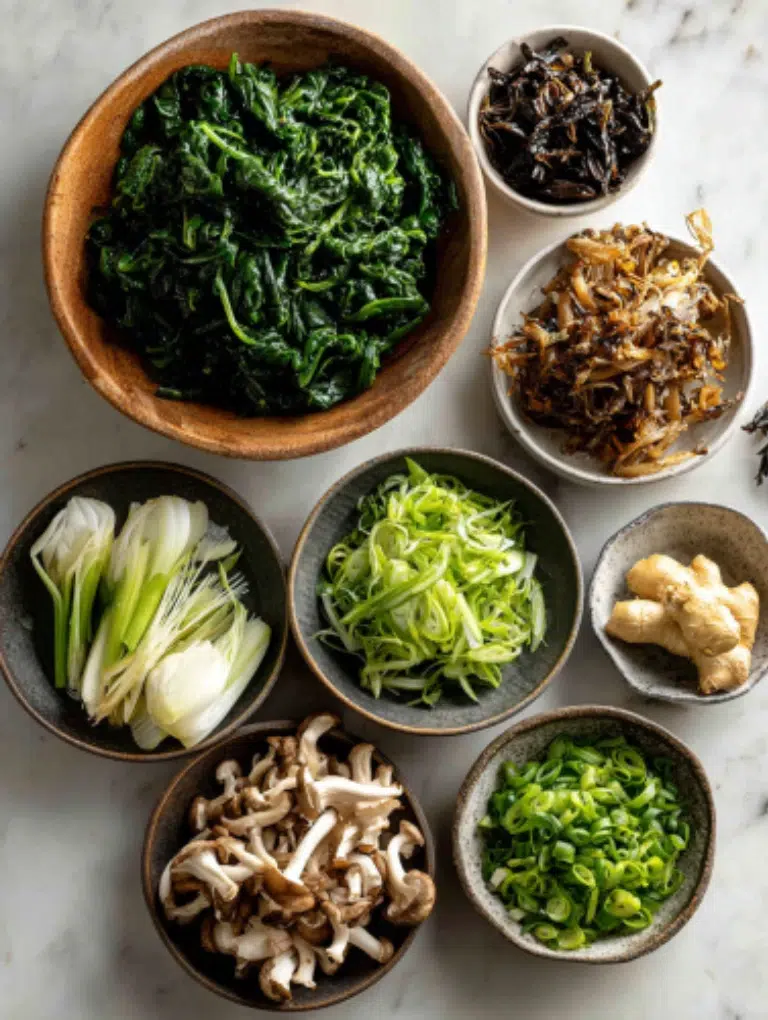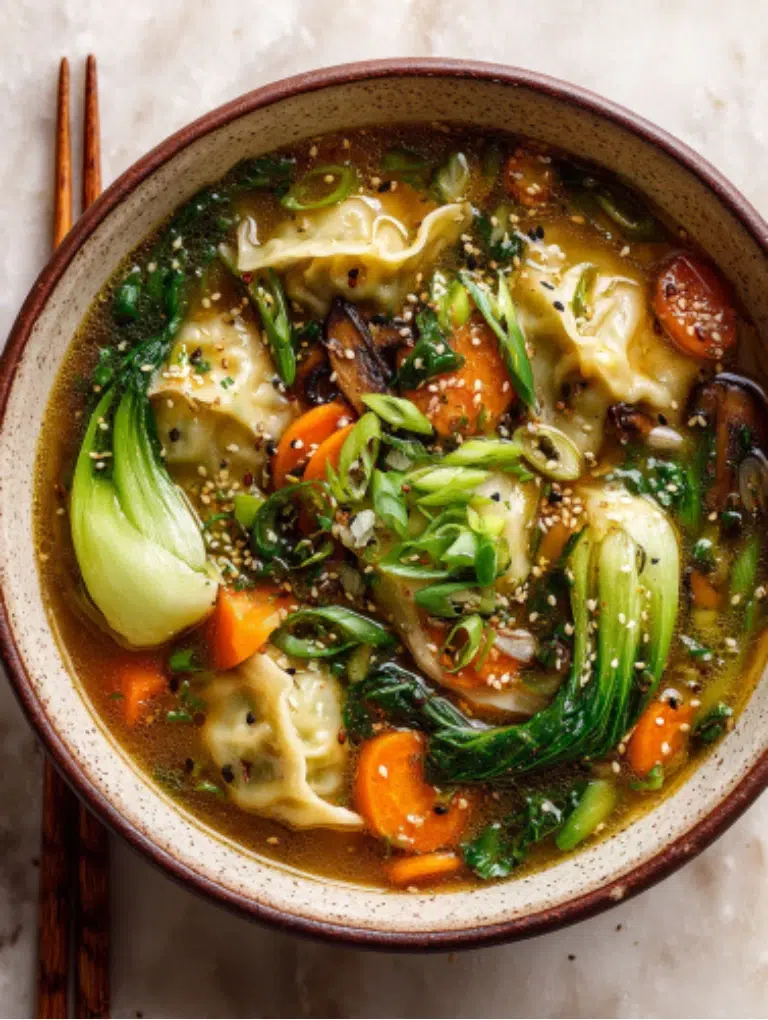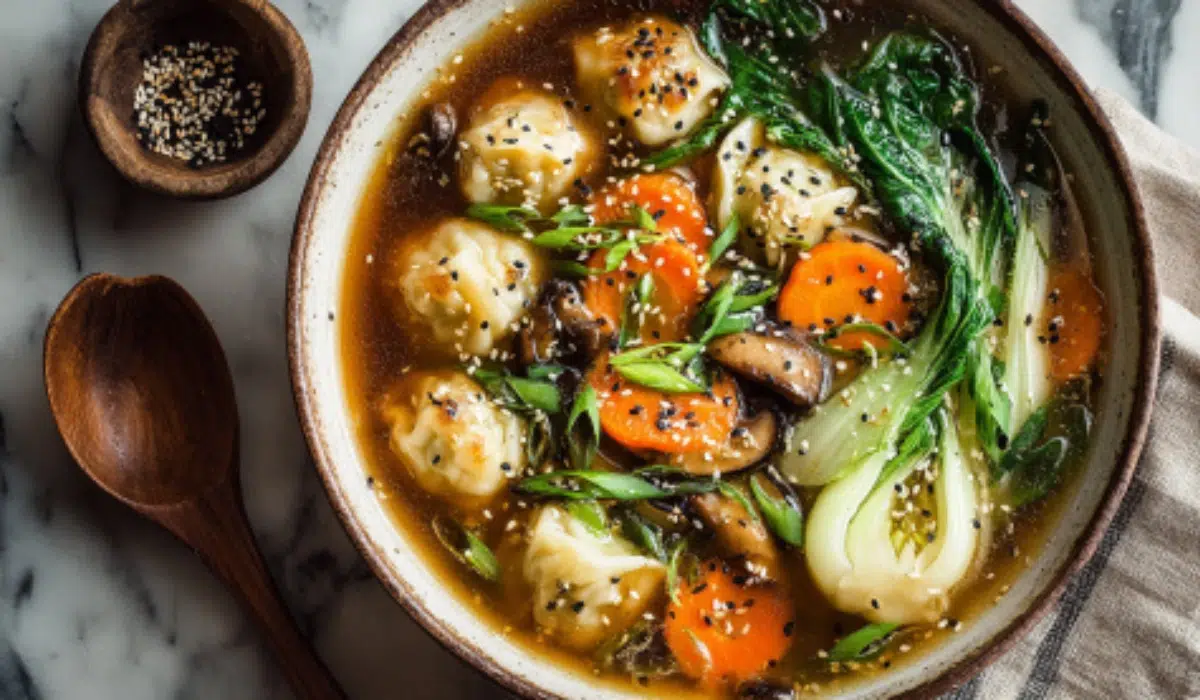Miso vegetable dumpling soup is the kind of dish that warms you from the inside out. A fragrant broth carries hints of garlic, ginger, and umami-rich miso, while tender dumplings add satisfying bites of comfort. This recipe shows you how to build flavor in minutes, using fresh vegetables and store-bought wrappers for convenience. It’s simple, cozy, and flexible, whether you want a quick weeknight dinner or a nourishing bowl to share.
Table of Contents
Why You’ll Love This Miso vegetable dumpling soup
- Quick and easy: Ready in about 30 minutes, perfect for busy evenings.
- Simple ingredients: Uses pantry staples like miso, soy sauce, and frozen dumplings.
- Comfort in a bowl: A balance of savory broth, tender dumplings, and fresh vegetables.
- Flexible and customizable: Works with gluten-free wrappers, vegan dumplings, or extra protein like tofu.
- Crowd-pleaser: Light yet filling, great for family dinners or casual get-togethers.
This soup stands out because it delivers rich depth of flavor without long cooking times. Each spoonful gives you a comforting blend of vegetables, miso, and dumplings that feels both hearty and nourishing.
Ingredients Needed

For the Wontons
- Wonton or gyoza wrappers (store-bought, thawed if frozen)
- 1 cup baby spinach, blanched and finely chopped
- 1 cup shiitake mushrooms, finely chopped
- 3 garlic cloves, minced
- 2 cm piece of ginger, grated
- 2 scallions, finely chopped
- 2 tablespoons soy sauce
- 1 teaspoon chili paste or Sriracha
For the Soup
- 4 cups vegetable broth or light miso broth
- 3–5 dried shiitake mushrooms
- 1 large piece of fresh ginger, julienned
- 2 tablespoons soy sauce or tamari
- 2 baby bok choy, halved or quartered
- 2 carrots, peeled and julienned
- 2 scallions, thinly sliced (for garnish)
- Optional: chili oil, toasted sesame seeds, ramen noodles, or snap peas
Notes & Substitutions
- Miso choice: White miso gives a mild, sweet flavor; red miso is stronger and saltier.
- Gluten-free option: Use tamari instead of soy sauce and gluten-free dumpling wrappers.
- Protein boost: Add cubed tofu or edamame to the broth.
- Low-sodium tip: Choose reduced-salt broth and add soy sauce gradually.
- Vegetable swaps: Napa cabbage, spinach, or kale can replace bok choy.
How to Make Miso Vegetable Dumpling Soup
1. Prepare the Dumpling Filling
Blanch spinach in boiling water for 1 to 2 minutes, squeeze out all moisture, and chop finely. Combine with chopped shiitake, garlic, ginger, and scallions. Stir in soy sauce and chili paste until the mixture is flavorful but not soggy.
2. Fold the Dumplings
Keep wrappers under a damp towel to prevent drying. Place 1 teaspoon of filling in the center, moisten edges, and fold into a half-moon. Press out air and pleat edges for strength. Repeat until you have 6 to 10 dumplings per person. Place on a towel-lined tray.
3. Cook the Broth
In a large pot, bring vegetable broth, dried shiitake, and julienned ginger to a boil. Lower heat to a gentle simmer and season with soy sauce. Taste and adjust with chili paste if you prefer more spice.
4. Blanch the Dumplings
In a separate pot of gently simmering water, add dumplings in small batches. Cook for 2 to 3 minutes, or until they float. Transfer to a plate while finishing the broth.
5. Add Vegetables
Drop bok choy and carrots into the hot broth. Let them soften for 2 to 3 minutes, keeping them crisp and bright.
6. Assemble and Serve
Divide dumplings among bowls. Ladle hot broth and vegetables over them. Top with sliced scallions and condiments like chili oil, sesame seeds, or a squeeze of citrus.
Pro Tips & Troubleshooting
Expert Tips
- Layer flavors: Sauté garlic and ginger briefly before simmering to deepen the broth.
- Temper the miso: Always dissolve miso in a ladle of hot broth off the heat before stirring it in. This keeps the flavor bright and preserves beneficial cultures.
- Fresh garnish: Add scallion greens, sesame oil, or chili crisp right before serving for a flavor boost.
Common Mistakes to Avoid
- Boiling miso directly: High heat dulls its flavor and probiotics. Always add it last.
- Overcrowding dumplings: Too many at once lower the water temperature, leading to soggy wrappers. Cook in batches.
- Overcooking vegetables: Drop bok choy and carrots in at the very end to keep them crisp and vibrant.
Handy Shortcut
- Short on time? Use frozen dumplings straight from the bag and simmer them directly in the broth for a fast, weeknight-friendly version.
Serving, Storage & Variations

Serving Ideas
- Ladle soup into deep bowls and top with a sprinkle of toasted sesame seeds.
- Add a drizzle of chili oil for extra heat, then pour a cup of Natural Mounjaro Tea to round out the meal.
- Pair with a side of steamed rice or a light cucumber salad for balance, and sip a Japanese Mounjaro recipe for a gentle ginger matcha finish.
- For a cozy touch, serve with a wedge of lime to squeeze over the top.
Storage
- Store leftover broth and dumplings separately to prevent sogginess.
- Keep in airtight containers in the refrigerator for up to 3 days.
- Dumplings can also be frozen uncooked for later use.
Reheating
- Warm broth gently over medium heat until hot but not boiling.
- Add dumplings just before serving to reheat without breaking them apart.
Variations
- Vegan: Stick with vegetable dumplings and use white miso for a milder broth.
- Gluten-Free: Use gluten-free wrappers and tamari instead of soy sauce.
- Spicy: Spicy: Stir in chili paste or top with chili crisp for extra kick, then enjoy a Japanese Mounjaro detox drink on the side.
- Protein boost: Add tofu cubes or shelled edamame to the broth.
Nutritional Information
Per Serving (approximate)
- Calories: 290
- Protein: 11 g
- Fat: 9 g
- Carbohydrates: 42 g
- Fiber: 5 g
- Sodium: 930 mg
Ingredient Nutrition Notes
- Miso paste: Provides probiotics that support gut health when added off heat.
- Mushrooms: Offer antioxidants and umami depth with very few calories.
- Bok choy and carrots: Supply vitamins A and C, fiber, and natural sweetness.
- Dumplings: Contribute carbs for energy and a satisfying bite. Use whole-grain wrappers if you want more fiber.
- Optional tofu or edamame: Boost protein and satiety while keeping the dish plant-based.
Use online tools like Cronometer or MyFitnessPal to double-check nutrition values if you adjust the ingredients.
Conclusion
Miso vegetable dumpling soup is a recipe that delivers comfort, speed, and flavor in every bowl. The fragrant broth, tender dumplings, and crisp vegetables make it a versatile dish that works for quick dinners or cozy weekends at home. It’s simple enough for beginners yet satisfying enough to impress guests.
If you give it a try, leave a comment and rating to share your experience. Pin it to your recipe board, or pass it along to a friend who loves easy comfort food. What variation will you try first extra spice, a vegan twist, or a protein boost? Let us know below!
Frequently Asked Questions
What type of miso works best for this soup?
White miso has a mild, slightly sweet taste that blends well with vegetables. Red miso is stronger and saltier, giving a deeper flavor. Choose based on your preference.
Can I use frozen dumplings or potstickers straight from the bag?
Yes, you can drop frozen dumplings directly into the simmering broth. They may need 1–2 extra minutes to cook through.
When should I add miso so I keep its live cultures?
Always whisk miso into a ladle of hot broth off the heat, then stir it back in. This preserves its probiotics and keeps the flavor fresh.
How do I make this gluten free without losing flavor?
Swap soy sauce for tamari and use gluten-free dumpling wrappers. The flavor stays rich, and you won’t miss the wheat-based wrappers.
How can I lower the sodium without dulling the broth?
Start with low-sodium broth, and season gradually. Add fresh herbs, ginger, or chili oil for flavor without extra salt.
Why do my dumplings turn soggy, and how do I fix that?
Soggy dumplings usually come from sitting too long in broth. Cook them separately in water, then add just before serving.
Does this soup freeze well, and how should I reheat it?
Freeze uncooked dumplings on a tray, then store in bags. The broth can be frozen separately. Reheat gently and add dumplings to simmer until tender.















